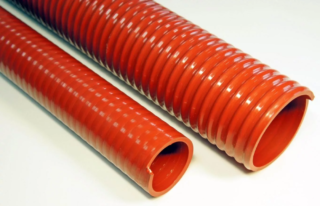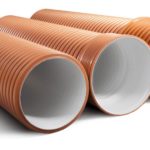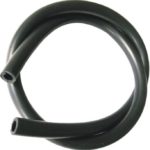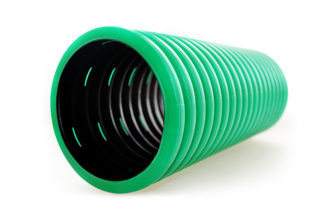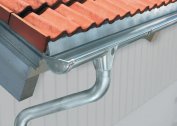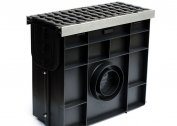Hoses for sewage - a kind of flexible pipes designed to transport wastewater (domestic, fecal, industrial, stormwater) from drainage holes, drainage and fecal pumps to the corresponding types of sewer lines. Flexible hoses are also widely used in sewage disposal equipment designed for pumping sewage pits and flooded water wells.
Materials of manufacture
Modern sewer sleeves are made of the following polymeric materials:
- polyvinyl chloride (PVC);
- stabilized polypropylene (PP);
- low pressure polyethylene (HDPE);
- synthetic rubber (rubber).
Hoses are resistant to the effects of aggressive wastewater, can be operated in a wide temperature range from -15-20 to + 50 + 60 0С, have high flexibility, do not ignite, are safe for the environment. For additional reinforcement, many of them are also reinforced with an inner cord layer, a steel spring, and a polyvinyl chloride spiral.
Types of sewer hoses
All hoses for wastewater, depending on the nature of their surface and scope, are divided into 3 large types:
- Corrugated pipes for external sewage - flexible hoses with a ribbed outer surface, designed for laying a courtyard sewer network of private cottages or apartment buildings and connecting them to the sewage collector. Such pipes are made of low-pressure polyethylene, polyvinyl chloride, resistant to negative temperatures and high loads. The internal diameter of the communications ranges from 110 to 1000 mm.
- Corrugated pipes for intra-house sewerage - corrugations with an internal diameter of 25-30 to 110 mm, used for laying an intra-house sewerage and for connecting siphons of washbasins, bathtubs, shower trays, and a toilet flush to it. Also, with the help of them, household appliances are connected to the sewer: a washing machine and a dishwasher.
- Smooth hoses made of rubber, PVC - sleeves with an internal nominal bore of 30 to 40-50 mm are used for drainage, fecal pumps, mobile dump trucks. They are widely used as pipelines in drip irrigation systems, in special devices for cleaning and washing sewer pipes from grease and other deposits.
We decided to corrugate sewer pipes to increase their strength and reliability, the possibility of laying under highways, railways, and airport runways.
Selection recommendations
When choosing hoses for sewage systems, they are based on the purpose and volume of the drain.
When laying external (courtyard) sewer networks, special HDPE corrugated pipes are used, PVC hoses less resistant to environmental conditions are used for internal sewage. The most flexible and inexpensive rubber hoses are used for drainage and fecal pumps.
For laying sewer highways collecting drains from a large number of apartments and houses, flexible corrugated hoses with a conditional internal diameter of at least 110 mm are used. When connecting individual household appliances, organizing the flow of water points (sinks, bathtubs, shower trays, etc.), PVC hoses with an inner diameter of up to 50 mm are used.
Installation Rules
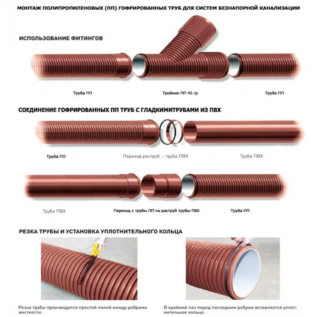 The order of installation of the sewer sleeve depends on its type and scope:
The order of installation of the sewer sleeve depends on its type and scope:
- Polyvinyl chloride corrugation for siphon - one end is screwed onto a drain siphon with a nut and a conical rubber gasket, and the other is inserted into a transitional rubber cuff pre-installed in the socket of the sewer pipe.
- Corrugated hose used to drain water from a washing machine or dishwasher - using a double-sided transitional internal nipple ("ruff") and two worm clamps connected to a standard flexible sewer outlet of a household appliance. The other end is inserted into the adapter rubber sleeve in the socket of the sewer intra-house pipe.
- Corrugated pipes of the external sewerage - for laying, they dig a trench with a slope of 1 cm by 1 m. At the bottom of the ditch, make a pillow of sand, sand-gravel, fine gravel 20-25 cm thick. Pipes with an inner diameter of up to 300 mm are connected using sealing gum and bell: for this, put a sealing gum on a 2-3 groove between the ribs of one pipe, lubricate it and the inner surface of the bell on the second pipe with special grease. After that, manually or with the help of a hand press, the pipe with sealing rubber is tightly driven into the second bell. Pipes with a diameter of more than 300 mm are connected using special thermal welding: a ring-shaped heating element is put on the joint of two pipes, the temperature of which contributes to the fusion and sealing of the seam.
- Smooth hoses - connect to the water-pumping pipes of fecal or drainage pumps using worm clamps.
- The corrugated rubber sleeve of the cesspool tanks for pumping sewage pits and wells is connected to the car's pump using special clamps.
Each of these connections, when properly implemented, provides a tight drainage of sewage into the sewer courtyard network, a common collector.
